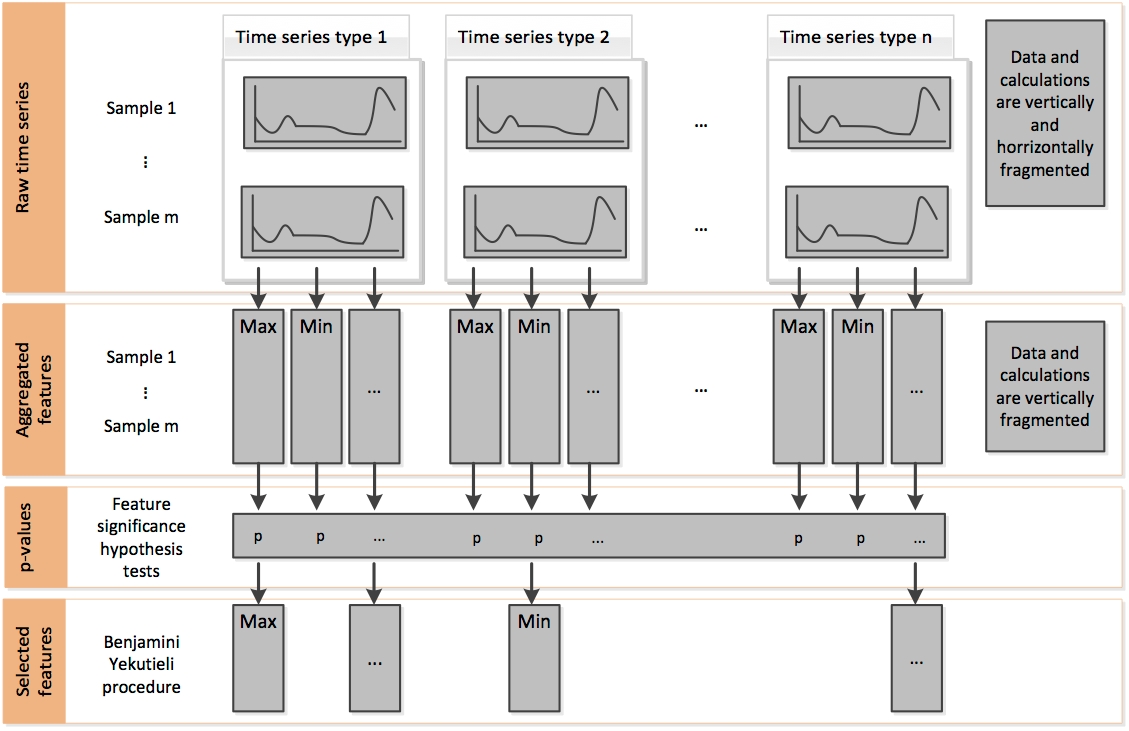5.3 自动特征生成与选择
下面将使用tsfresh包演示如何进行自动特征生成和特征选择
from tsfresh.examples.robot_execution_failures import download_robot_execution_failures,load_robot_execution_failures
from tsfresh import extract_features,select_features
import pandas as pd下一步需要注意,由于国内网络的限制,直接运行时会导致连接失败,此时有两个办法 1)在该地址 https://github.com/MaxBenChrist/robot-failure-dataset 手动下载lp1.data 2)在网站https://www.ipaddress.com 输入https://raw.githubusercontent.com 的真实ip,然后在C:\Windows\System32\drivers\etc下的hosts文件中添加类似这样的几行185.199.108.133 raw.githubusercontent.com
download_robot_execution_failures() #下载数据
timeseries, y = load_robot_execution_failures() # 加载数据timeseries.columns #该数据集包含8列,其中id表明类别id,time为时间轴,其他6列为不同维度的时间序列值Index(['id', 'time', 'F_x', 'F_y', 'F_z', 'T_x', 'T_y', 'T_z'], dtype='object')# 自动抽取全部特征
X_extracted = extract_features(timeseries,column_id = "id",column_sort = "time")
X_extractedT_x__variance_larger_than_standard_deviation
T_x__has_duplicate_max
T_x__has_duplicate_min
T_x__has_duplicate
T_x__sum_values
T_x__abs_energy
T_x__mean_abs_change
T_x__mean_change
T_x__mean_second_derivative_central
T_x__median
...
F_z__permutation_entropy__dimension_5__tau_1
F_z__permutation_entropy__dimension_6__tau_1
F_z__permutation_entropy__dimension_7__tau_1
F_z__query_similarity_count__query_None__threshold_0.0
F_z__matrix_profile__feature_"min"__threshold_0.98
F_z__matrix_profile__feature_"max"__threshold_0.98
F_z__matrix_profile__feature_"mean"__threshold_0.98
F_z__matrix_profile__feature_"median"__threshold_0.98
F_z__matrix_profile__feature_"25"__threshold_0.98
F_z__matrix_profile__feature_"75"__threshold_0.98
1
0.0
1.0
1.0
1.0
-43.0
125.0
0.214286
0.071429
0.038462
-3.0
...
1.972247
2.163956
2.197225
NaN
NaN
NaN
NaN
NaN
NaN
NaN
2
1.0
1.0
1.0
1.0
-53.0
363.0
3.785714
-0.071429
0.153846
-3.0
...
2.397895
2.302585
2.197225
NaN
NaN
NaN
NaN
NaN
NaN
NaN
3
1.0
0.0
1.0
1.0
-60.0
344.0
3.214286
0.071429
-0.076923
-5.0
...
2.397895
2.302585
2.197225
NaN
NaN
NaN
NaN
NaN
NaN
NaN
4
1.0
1.0
0.0
1.0
-93.0
763.0
3.714286
-0.428571
-0.192308
-6.0
...
2.271869
2.302585
2.197225
NaN
NaN
NaN
NaN
NaN
NaN
NaN
5
1.0
0.0
0.0
1.0
-105.0
849.0
4.071429
-0.357143
0.000000
-8.0
...
2.271869
2.302585
2.197225
NaN
NaN
NaN
NaN
NaN
NaN
NaN
...
...
...
...
...
...
...
...
...
...
...
...
...
...
...
...
...
...
...
...
...
...
84
1.0
0.0
0.0
1.0
5083.0
1825597.0
18.857143
15.285714
-0.538462
394.0
...
1.366711
1.609438
1.831020
NaN
NaN
NaN
NaN
NaN
NaN
NaN
85
1.0
0.0
0.0
1.0
-511.0
18023.0
2.785714
-1.214286
0.192308
-33.0
...
1.972247
2.163956
2.197225
NaN
NaN
NaN
NaN
NaN
NaN
NaN
86
1.0
0.0
0.0
1.0
-987.0
67981.0
3.928571
-3.500000
-0.153846
-65.0
...
0.600166
0.639032
0.683739
NaN
NaN
NaN
NaN
NaN
NaN
NaN
87
1.0
0.0
0.0
1.0
-1921.0
247081.0
6.642857
-0.357143
0.461538
-126.0
...
1.366711
1.609438
1.831020
NaN
NaN
NaN
NaN
NaN
NaN
NaN
88
1.0
1.0
0.0
1.0
-304.0
6408.0
2.428571
-0.714286
0.230769
-21.0
...
2.397895
2.302585
2.197225
NaN
NaN
NaN
NaN
NaN
NaN
NaN
F_x__length
F_x__large_standard_deviation__r_0.05
F_x__large_standard_deviation__r_0.1
F_y__length
F_y__large_standard_deviation__r_0.05
F_y__large_standard_deviation__r_0.1
F_z__length
F_z__large_standard_deviation__r_0.05
F_z__large_standard_deviation__r_0.1
T_x__length
T_x__large_standard_deviation__r_0.05
T_x__large_standard_deviation__r_0.1
T_y__length
T_y__large_standard_deviation__r_0.05
T_y__large_standard_deviation__r_0.1
T_z__length
T_z__large_standard_deviation__r_0.05
T_z__large_standard_deviation__r_0.1
1
15.0
1.0
1.0
15.0
1.0
1.0
15.0
1.0
1.0
15.0
1.0
1.0
15.0
1.0
1.0
15.0
0.0
0.0
2
15.0
1.0
1.0
15.0
1.0
1.0
15.0
1.0
1.0
15.0
1.0
1.0
15.0
1.0
1.0
15.0
1.0
1.0
3
15.0
1.0
1.0
15.0
1.0
1.0
15.0
1.0
1.0
15.0
1.0
1.0
15.0
1.0
1.0
15.0
1.0
1.0
4
15.0
1.0
1.0
15.0
1.0
1.0
15.0
1.0
1.0
15.0
1.0
1.0
15.0
1.0
1.0
15.0
1.0
1.0
5
15.0
1.0
1.0
15.0
1.0
1.0
15.0
1.0
1.0
15.0
1.0
1.0
15.0
1.0
1.0
15.0
1.0
1.0
...
...
...
...
...
...
...
...
...
...
...
...
...
...
...
...
...
...
...
84
15.0
1.0
1.0
15.0
1.0
1.0
15.0
1.0
1.0
15.0
1.0
1.0
15.0
1.0
1.0
15.0
1.0
1.0
85
15.0
1.0
1.0
15.0
1.0
1.0
15.0
1.0
1.0
15.0
1.0
1.0
15.0
1.0
1.0
15.0
1.0
1.0
86
15.0
1.0
1.0
15.0
1.0
1.0
15.0
1.0
1.0
15.0
1.0
1.0
15.0
1.0
1.0
15.0
1.0
1.0
87
15.0
1.0
1.0
15.0
1.0
1.0
15.0
1.0
1.0
15.0
1.0
1.0
15.0
1.0
1.0
15.0
1.0
1.0
88
15.0
1.0
1.0
15.0
1.0
1.0
15.0
1.0
1.0
15.0
1.0
1.0
15.0
1.0
1.0
15.0
1.0
1.0
官方文档的这个流程展示了用fresh算法进行特征选择的思路,简单来说,它是通过比较不同时间序列类别下特征的显著性差异来确定是否要挑选出这个特征。

除此之外,还有其他用于特征选择的方法,如recursive feature elimination (RFE),不过tsfresh包并没有内置这种方法,可以结合sklearn中的RFE方法自行组合使用。
Last updated
Was this helpful?